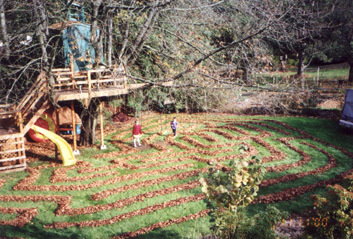Todd Klein's Blog, page 326
November 22, 2011
And Then I Read: NEXUS ARCHIVES Volume 12
Images © Mike Baron & Steve Rude.
In one sense, this was a dark time for NEXUS, issues 74-80, the final ones published by First Comics. Steve Rude, the original artist and co-creator is absent except for one cover, excerpted above. All the art on the main stories is pencilled by Hugh Haynes, with several inkers. I can't say I like it; there are a few good moments in each issue, but also many where the off-model art on the main characters, or awkward and just plain bad drawing is distracting. There are also places where the color registration is off by enough to be distracting.
Despite all that, I enjoyed reading Mike Baron's stories quite a lot! He's in fine form here, from the inevitable battle between the new Nexus, Stan and the old Nexus, Horatio when Stan begins to get trigger-happy and admits he enjoys killing. An issue focusing on Horatio's daughters and their mother is fascinating, and the return of the Loomis sisters is riveting. Then there are all the smaller character bits that Baron does so well: moments of warmth and humor, chilling cold-bloodedness, crazy science, romance, politics, and wacky alien thinking (the Merk). Above all, there are many tough moral questions and decisions facing both Nexuses (Nexii?) and their friends and enemies. This is always at the heart of the series, and Mike Baron's knowledge of both the baser and nobler sides of human nature makes for great reading.
Here's one of the pages of art I liked, a pretty good effort in the Steve Rude direction. And Haynes does have a nice handle on unusual architecture and cool machines. If it weren't so easy to compare his work to Rude's I'd probably like it better. The painted covers by Les Dorscheid are quite good.
In all, this collection is well worth reading, though I admit I skipped the backup stories. Recommended.
November 21, 2011
And Then I Read: GREEN LANTERN CORPS 1 & 2
Images © DC Comics, Inc.
While some of the New 52 books I've been reading lately present DC's heroes with revamped or reset origins, this one seems to be much the same as before. There is a nod to origins with Guy Gardner and John Stewart on Earth each trying to see if they still have a viable civilian life and career there, but the consensus seems to be: they don't. So, back to Oa they go, to be greeted warmly by their friends and fellow GLs. Guess it's hard to go back once you've seen Oa.
The main plotline in these books is a largely unseen group on a barren planet that is ruthlessly collecting resources from other planets, and callously killing the inhabitants of those planets in the process. A few Green Lanterns, too. Doesn't go over well on Oa, and Guy and John head a task force to find out what's up. This group is powerful, with a large amount of willpower themselves, so it looks to be an interesting conflict.
The art by Fernando Pasarin and Scott Hanna is highly detailed and realistic. Almost too detailed at times for me, clouding the storytelling a bit, but certainly well drawn. In all, a fine job.
Recommended.
November 20, 2011
And Then I Read: THE LOST GATE
© Orson Scott Card.
I've been a fan of Card's writing for many years, and I tend to prefer his fantasy to his science fiction, so I was delighted to find this book recently, the beginning of a new fantasy series, apparently (assuming this one does well).
The protagonist, Danny North, has grown up in a household of godlike men and women with various kinds of magical talents, though he himself seems to have none, and is therefore generally ignored by the adults and tormented by the other children in the family compound in a remote rural area. Imagine Danny's surprise when he suddenly discovers he has the power to create "gates," openings through space from one place to another, making him one of the most powerful kinds of mages. Trouble is, gate mages are hated by all the other mages, not only in his own family, but in the others around the world they compete with for power and wealth. It's partly a jealousy thing, partly the fact that centuries ago a powerful gate mage, Loki, cut them all off from their true homeworld of Westil, trapping them on Earth where their powers are gradually fading.
As soon as Danny realizes what his true nature is, he knows he has to get far away from all the other mages, and he goes on the run, ending up in Washington, D.C., where he's taken under the wing of Eric, a young con artist. When Eric finds out about Danny's powers, he sees it as a foolproof way to make a lot of money in burglary. That doesn't go so well for either of them.
Meanwhile, on the world of Westil, where things are still very medieval, a young man who has been trapped inside a tree for centuries is suddenly freed, and Wad, as he is called, begins a new life inside a royal castle, where his own secret abilities as a gate mage lead him into close associations with the royals. All kinds of plots, spying and betrayals are going on in this kingdom, and Wad ends up in the middle of it, as well as in the Queen's bedroom.
Back on Earth, Danny gradually finds friends who try to help him learn about and develop his powers, but it's tough going since all such knowledge has long been hidden away or forgotten. Danny's attempt to make a new life for himself in a normal High School only leads to more complications, and eventually the lives of the two gate mages become entwined in a way that will prove tragic for one of them.
This is a great read, though a few times I did wonder whether it was going places I wanted to go, especially when young Danny becomes a burglar. Never fear, it all plays out effectively, and Card has set up a system of magic that has nearly endless possibilities for good stories, I think. Highly recommended.
November 19, 2011
Leaf Work
Here's a chance for those of you who don't have lawns with leaves to remove, or lawns at all, to feel smug. Most of the time I like living in the woods, but this time of year, not so much. Last weekend I had all the leaves cleaned up, but only about a third were down from the oak trees.
This week we had the Big Drop, when most of those oak leaves decided it was time to go. We also had two days of rain making them nice and wet at the bottom. Sometimes I rake, but today I used the leaf blower. I think they each take about the same time.
After about two hours I had much of it done.
Though, of course, there are still leaves falling from the roof, and some of the remaining 10 percent or so from the trees. Some of those will hang on until spring.
There's about another hour to do, and I'll get to it tomorrow. And probably another round of final raking in a week or two.
When I was a teenager I used to make leaf mazes in our family's large yard, similar to this one I found a picture of online. Then my brothers and I would play tag in them. That's about the last time I remember having a lot of fun raking leaves!
November 18, 2011
And Then I Read: WONDER WOMAN 1 & 2
Images © DC Comics, Inc.
Another character who seems to be getting a fresh start that goes back to her early days. But perhaps the most interesting gambit of writer Brian Azzarello is to not even bring Diana into his story in issue 1 until page 10. Before that we get some mysterious moments with an apparent sun god and three young women he's making use of in a penthouse overlooking Singapore, then another young woman in Virginia confronting a very unusual half-man half-bird intruder, then being attacked by two centaurs. The bird man is another godlike being who sends the young woman, Zola, directly to London and Diana's apartment, where her reception is surprisingly cordial. Maybe it's the special key in her hand. Wonder Woman returns with Zola to face the centaurs, and proves herself a powerful and clever warrior.
Issue 2 puts us inside the home of another god, a goddess in this case, and her punkish daughter, as seen on the cover above, both determined to kill Zola. Diana brings the girl to Paradise Island, thinking it will be a safe haven, but of course things don't work out that way!
Cliff Chiang's art on this book is a delight. First, he simplifies forms in a somewhat cartoony way that manages to still read as fairly realistic and serious. Second, he makes Diana look quite young, and gives her energy and an apparent love for action that works great with the story. Azzarello is feeding in background gradually, such as a recap of Diana's origin in issue 2, but mostly this is an action/adventure story with fantasy elements, and for now is avoiding the heavy load of back story inherent in the character's mythic background and Greek pantheon. I think it's going there, but in a refreshing way.
Recommended.
November 17, 2011
And Then I Read: AQUAMAN 1 & 2
Images © DC Comics, Inc.
Aquaman has always been considered a second-string character by comics fans, despite a long history, membership in the JLA, and some popular series. So, I was interested to see how Geoff Johns would go about putting him in the top tier in this book, as I believe is his intention. (And Geoff's track record with Flash and Green Lantern, among others is quite good!)
To be a more powerful and important Aquaman, then, you must: Say little to the common folk. Frown a lot (indeed, most of the time). Carry a very large and dangerous trident around at all times (on your back when not in your hand). Admit you've heard the Aquaman jokes, and are not amused. Show off your scale armor by letting bullets bounce off it (the old Superman trick). In your off-time revisit your old haunts, like a diner where your dad used to bring you, but leave in a huff when the Aquaman jokes come out. Make a pledge to live on land, and not return to Atlantis. Make your home in a cool lighthouse, with the lovely Mera. Respond to calls for help from any seaman or seaman's friend, even when attacked by undersea monsters (okay, that hasn't changed, has it?)
Despite my hopefully gently ribbing, this was a great read, and I'm looking forward to more.
Here's the man showing off his trident and his strength. No water in sight, none needed, apparently. The art by Ivan Reis and Joe Prado is terrific, as expected, and this looks like a real rebirth for one of DC's oldest characters. Hope so!
Recommended.
November 16, 2011
And Then I Read: THE FLASH 1 & 2
Images © DC Comics, Inc.
What an interesting choice for writers on this book: the artist and the colorist! I've been enjoying Francis Manapul's art on FLASH for some time, and Brian Buccellato does a fine job of coloring. I like to see folks broadening their creative options into other areas of comics, and came to this book hoping to enjoy it. And I did!
Flash's origin has been reset once again. Barry Allen is back in his police scientist day job, while Iris West is a reporter on the trail of his Flash alter-ego, but otherwise not involved with Barry. Flash seems to have some new tricks: a costume that forms around him in an instant, emanating from his Flash ring, for instance. He also seems to make a lot of mistakes, and feels new at this Flash thing, which is a nice touch. He's up against a gang of high-tech thieves, one of which he knows well, creating a moral dilemma for the speedster. Then there's his scientist friend Dr. Darwin Elias, who is helping Flash explore his abilities, and encouraging him to try to think as fast as he moves. I think this is a new angle for The Flash, and it's brought to life visually in interesting ways by Manapul:
His art continues to be completely charming, in a style that uses the softness of watercolors to great effect, and I guess part of that is the work of colorist Buccellato, too. Sal Cipriano's lettering also looks good, making this book a delight to read. Barry's super-speed thinking is a little hard to follow in places, but it's a much more interesting approach to his speed powers than I've seen in a while, so I'm willing to take the extra time to work it out.
Highly recommended.
November 15, 2011
And Then I Read: RETROACTIVE BATMAN, GREEN LANTERN
Images © DC Comics, Inc.
These are the other two Retroactive titles I chose to read. Len Wein always wrote a pretty good Batman, and this story is no exception. It brings in many of the characters from Batman's world in the 1970s, as well as three new villains patterned after even older villains from the 1950s I think. The villains are not the real focus, though, it's the relationships that make the story interesting. Tom Mandrake does a nicely moody and mysterious Batman, though I didn't like his Bruce Wayne as much. The coloring is again too dark for this absorbent paper, but in all, a fine effort by all involved.
Recommended.
I didn't like the writing by Dennis O'Neil as much on this one, and unfortunately the second story is one of his gems with Neal Adams, making for a tough comparison. I thought the motivation of the villainous arrow-shooter was pretty weak, and the emotional connection it was reaching for didn't work for me. Then there's the scene where Dinah Lance, the Black Canary, is shot in the chest with an arrow, and turns up bandaged but smiling a few pages later. Huh? The art by Mike Grell looks good, though I thought not as good as his recent work on THE WARLORD. Still worth a look.
Mildly recommended.
November 14, 2011
And Then I Read: RETROACTIVE JLA
Images © DC Comics, Inc.
This series of one-shots was a fun idea to fill in some time between the end of many titles and the launch of the New 52. Round up some creators from past decades and give them a chance to recreate their past glories in a book-length story, then pair it with another book-length story from that previous era by (at least some of) the same folks. Actually, it sounds like a rather terrifying idea for the creators! I looked through a bunch of these, and picked out three to read. This was the one I liked best.
In fact, I thought the new story by Giffen, DeMatteis and Maguire was excellent, full of all the fun of their original run on this team (in several configurations). It's quite funny, but doesn't so much laugh at the characters as it does point out how silly super-heroics could seem in a more realistic world than comics often presents. Well, okay, it does laugh at the characters too, sometimes.
So, we have a group of villains plotting against the JLA, as usual, but they're completely hopeless until they happen upon some Kirby Fourth World technology. That's what drives the action and the story, and it's really quite well done. It's even kind of fun to see Guy Gardner as a dunce again, as he was in these books.
Kevin Maguire's art is, if anything, even better than back when, inking his own work. Some of his characters seem to have put on a little weight in their faces, but otherwise it's very much the same style. Except that, in the accompanying old story, he was inked by Terry Austin, a very different look. The book is printed on a very absorbent paper, and the coloring is pretty heavy with lots of modeling, so that does make things a bit muddy at times, but otherwise there's nothing to knock in this new JLA story.
Recommended.
November 13, 2011
Rereading: A PRINCESS OF MARS
Okay, so I've had an iPhone for about six months now, and one of the apps that comes with it is iBooks. I don't have much interest in buying new books to read on it, but out of curiosity I've downloaded a few free older books, and I've now read this entire novel on my phone, in small moments here and there. It was surprisingly easy to read on the phone: the app text is large enough for easy reading. The main difference is that there's a lot fewer words per screen than there would be on the page of a book, but that's not a problem.
I have the entire Burroughs Mars series in Ballantine paperback editions that I bought and read in the 1960s, but I don't believe I've read any of them since. That's over 40 years ago, and I found I didn't remember that much of the book. Essentially I remembered the opening, the basic setup, the main characters, and a few action scenes, that was about it. The rest was essentially new.
And it read quite well! Burroughs' prose is inviting and not at all stuffy or long-winded. He writes of pulp heroics, but in a reasonably believable way that still works for me. The premise of Burroughs' Mars may have been marginally believable when it was written about 100 years ago, but even then the idea that the planet was warm enough for everyone to go around essentially nude (with metal ornaments) was not a very scientific idea even then, I'd bet. More of a fantasy wish-fulfillment idea. That said, Burroughs does not exploit the visual concept of that idea much. He does not dwell on the nakedness of even his beautiful heroine Deja Thoris, but the idea is always there in the background, and I'm sure titillated readers of the time, and my young self as well. Setting aside the impracticality of fighting naked, it made Burroughs' Mars a place one might want to see and visit! Visual descriptions of the planet, it's beasts and men and environment, are generally creative and memorable: Earthlike in some ways, with enough alien elements to make the story fresh.
Other aspects of the story do give at least a nod to scientific ideas about the planet: lesser gravity giving hero John Carter almost early Superman strength and jumping ability, for instance. The problem of little breathable air on Mars is handled by an ingenious invention of Atmosphere factories, ancient machines that create oxygen, one would assume, one of which Carter visits.
The characters in this book are dominated by the huge green Martians, a cruel, heartless race that Burroughs describes with gusto, making Carter's capture by them a perilous situation even for him. Gradually allies are found, though, and the arrival of another prisoner, the beautiful red Martian princess, sets the rest of the story in motion in thrilling action scenes that culminate in a massive siege of a Martian city that would thrill any Star Wars fan.
The book ends on something of a cliffhanger, though there's a resolution as well to explain, if not satisfy, that ending. Of course Burroughs was writing for the pulps, and had every reason to make this story a serial if readers liked it, so that makes sense. And readers must have: the series went on for years.
I'm reading the second book now, "Gods of Mars," also on my phone. Don't know if any others are available there, I haven't checked yet. In any case, if you haven't read this series, I recommend it. Perhaps not quite as well-written as the early "Tarzan" books, but quite good fun for action and adventure story fans. Here's a link to the Project Gutenberg text used by iBooks:
Todd Klein's Blog
- Todd Klein's profile
- 28 followers

























